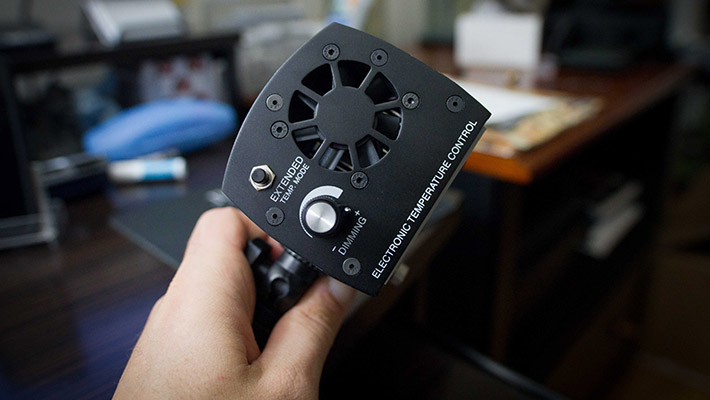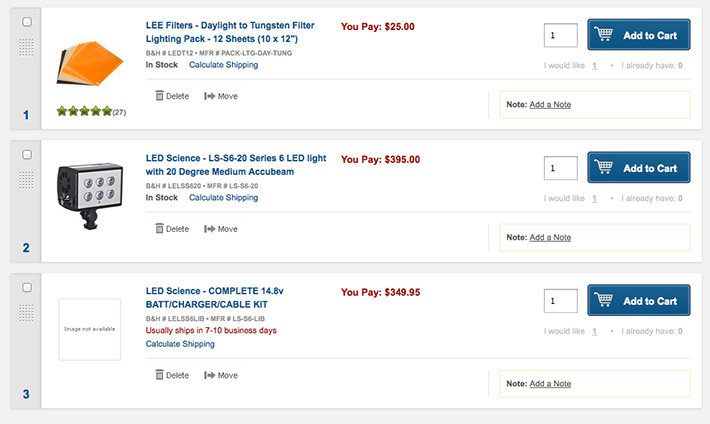For event videographers, shooting in dimly lit conditions can be big challenge to deal with, and in certain cases an on-camera light is the solution. In this review of the LED Science LS-S6-20, I’ll tell you why this light may or may not be a good choice for you.
Introduction
LED Science is relatively new company, with 3 versions of an LED light to choose from, each with varying light beam angles. I got my hands on the 20 degree version, but besides output and spread, all other comments about the build and features will apply to the other models as well. (There are 10, 20, and 35 degree models)
This light’s primary purpose is to be an on-camera light for event videographers. Some scenarios where it might be useful include: wedding receptions, parties, on-the-go interviews, and more. It could also be used in a studio setting, or perhaps as a special light you can hide on a set, due to its small size. It’s AC powered, but battery adapter kits can be purchased separately.
The LS-S6 has a dimmer control, with electronic ramping built in so that when you dim above 0%, it doesn’t change too quickly. It has a DMX port, a shoe mount, and a ¼-20” thread on the bottom of the mount. The light comes with a screw on diffusion panel and an AC power cord.
According to the published photometrics, it has a very high light output:

Build quality
This light is about the size of a wide angle lens, and weighs around 2 pounds. The light itself feels strong and would stand up to being dropped or knicked a bit. The shoe/tripod adapter is unfortunately made from a hard plastic, and isn’t as solid as it could be. The dimmer feels smooth, and controls are well labeled.

Side control for the dimmer works just fine, but I wish the jack for power was located on the bottom of the unit. The LS-S6 has fans built into it, and they do make a small amount of noise when running.

Overall, it looks a bit overweight, and needs to lay off fast food for a while. For not having a battery built into it, I’m rather surprised by its size. Most LED lights are flat by comparison.
Features
I’ll just come out and say it: this light is very bright for its size. Heck, it’s brighter than the Zabolight 1x1 I recently reviewed, and that light is much bigger (and more expensive) in size.
For a small package, it packs a big punch. It’s blindingly bright. Compared to a Zabolight mini-fresnel, which is close in terms of price and size, the LS-S6 is two whole stops brighter at a distance of 4 feet. Here is what I mean in terms of measurable data:
At 5 feet away, I took these meter readings for both lights:
Zabolight Mini Fresnel - f4, 1/48, ISO 640
LED Science LS-S6 - f8, 1/48, ISO 640
The LS-S6 has decent throw too, and holds decent brightness at a distance. Keep in mind that quantity of light is only half of the picture. Quality of light is important. In my tests using this on-camera, I got the deer-in-headlights look. This is typical for on camera lights. With the diffuser on, it it smoothed out a bt, but it definitely skewed warm (I was on my daylight preset) in the color temperature. Below is a still frame from a video I shot while testing this unit. I was about 4 feet away, camera set at f4, 1/50, ISO 320.

While the light's output and size are great, I’m not too thrilled about other features that it’s lacking. In my tests, I found the light temperature to be closer to about 4700K than its advertised 5400K. Why it’s daylight balanced in the first place is actually confusing for me, since I see this product being for indoor event video work, where lighting is likely going to be in the 2800-3700 range. Personally, I’d be OK with the tradeoff of less light output for a fixture that can dial in color temperature.
Let’s talk about powering this unit for a moment. You can plug it into a wall, but it comes with a painfully short cord for that. You definitely need an extension cord. But wait, this is supposed to be an on-camera light, right? What about a battery?
I’m glad you asked. The only way to battery power this unit is by using large battery brick plates that have a D-tap port (like for Anton Bauer or V-Mount batteries). You know, those behemoth batteries that are heavy and expensive. Yes, there are lot of higher-end video cameras that power themselves off of these bricks, but most event shooters I know try to stay light and fast! So for LS-S6 users, they will need a battery, shoulder bag, and a charger. I’ve shot plenty of weddings with a battery bag for a light, and it’s a pain. When there are many on-camera LED lights available today that come with a battery mount built in, I think LED Science might be a bit off target.
Price
It’s competitively priced at $400, which for its output, is a fantastic price. However, hidden costs come from the battery pack you would want, and CTO filters. So, here’s my shopping cart with everything I actually need to get the most out of this light:

So now, your total cost is $769.95. For that price, you can explore other options. For example, you could get two Ikan iLED312v2 lights for about the same price. These are bi-color LEDs, plus have barndoors, attachable batteries with included chargers, and the kit even comes with a bag and stands (they can be camera mounted though). They are not nearly as bright, but much more versatile. So it really comes down to what is going to suit your needs.
What I liked:
Extremely bright
Inexpensive – couldn’t find other on-camera LEDs at a similar price with a matching output
Electronic dimmer
What Could be Improved:
Cheaper, more efficient battery solution
Would prefer bi-color LEDs, or at least a choice of 3200K
My tests showed the light measured closer 4700K than 5400K
No barn doors
Clunky mount
No company information on website
Closing Thoughts
If you have a need for a high output on-camera LED, and you already own a battery kit, or shoot with a camera that has a D-tap port, this is a great choice. It could also be used in special applications for stage or set work, where hiding a bright, compact light is needed. For all other event shooters, especially DSLR folks, I’d suggest looking elsewhere. The high output isn’t worth the pain and price of dealing with large battery bags, unknown companies, and awkward mounts.
**As with all our reviews, this was an independent process and LED Science nor Ikan Corp. are paying or sponsoring myself or Fstoppers in any way.**







How can it be called 'low cost' when the package costs $770? It might be relatively inexpensive when comparing it to panels giving out a similar output, however when compared to typical on-camera LED lights it's quite expensive.
I feel like you could just buy a halogen work light (~$22) and have an assistant to hold it.
Plus, the light in that photo example is terrible
As you said yourself, the light is inexpensive when compared to
panels with similar output. Also, as stated in the article it's really
for shooters who already have the means to power it with a battery... so
they wouldn't have to buy the whole kit.
On-camera LEDs range greatly in terms of quality and light output, but if you can find a cheaper, brighter, on-camera LED, please share what you come up with.
I think the HDR-300 from F&V is a really great LED light and way cheaper!
395$ a low cost camera light? Do you know the market? Keep going Mike.
$770 for that?! Inexpensive you say?! Are you out of your mind, Mike? I've seen plenty of on camera lights that cost a fraction of this one, that put out very good quality light.
Hmm I don't think so. I researched on camera LEDs, comparing output and cost before deciding that $400 was cheap compared to the output you can get from it. If I'm wrong, please link me to an on-camera LED light that is cheaper and has a greater output I would be happy to change my opinions.
Plenty of hotshoe LEDs made in China sell for about 20-60 bucks, depending on quality. 60 bucks will get you something real nice. Stop being idiots.
Real fail of an Ad here
Inexpensive? What a joke :)
I got CN-160 and it's a pretty good light for the price - paid $30. Yes it needs Eneloop rechargeable batteries and a charger for another $40 but for $70 alltogether it's a great deal.
or use the adapter for Sony and other brand battery packs...
get some pretzel head torch and a diffuser at the front yaa I think that would do the same ....over priced kit load better alternatives out there now .....cycle light work even better from MOON